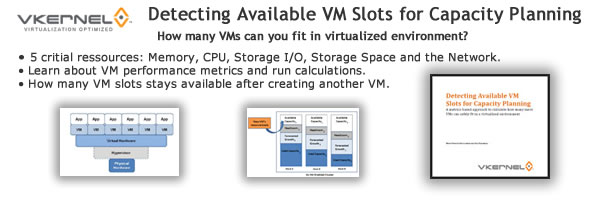A new whitepaper from vKernel showing a metrics-based approach to calculate a number of VMs which can fit in your virtualized environment.
This free resource publication from Alex Rosenblat and Ken Latimer shows you some deep dives into some metrics which one hast to take into consideration when making a calculation of how many VM slots are available within existing virtual infrastructure and how many more VMs can fit in.
There is quite a few nice workflows and graphics in this whitepaper, which is 18 pages long. So many interesting schemes and scenarios which brings the purely scientific approach to calculating the VM slot sizes.
The 5 critical resources to take into consideration: Memory, CPU, Storage I/O, Storage space and the network…
This whitepaper is destined to VMware admins which will be able to:
– Extract VM performance metrics and run calculations to see how much available capacity remains in physical resources.
– See when resource contention exists and must be addressed before engaging in capacity planning.
– How many available slots remains when creating new VMs.
– See some additional aspects which are needed to take into consideration within virtual infrastructure.
A quick quote from the Free White paper:
Without full visibility through all layers of the virtualization stack, capacity planning requires an iterative, trial ‐and‐error process. This is the art of capacity planning, and some IT managers are able to achieve acceptable results. But, the process is time‐consuming and by definition, error‐prone, and can lead to sub‐optimal results………..
………For example, will the new applications be running in a production or a development environment? In addition, are either of these environments partitioned somehow, such as by department or function? Note that a comprehensive capacity planning effort is likely to involve all infrastructure areas.
It is also important at this stage to consider the service level requirements and criticality of each new or anticipated application, as well as any datastore considerations. These issues are particularly important in the production environment, but may also be important for performance or quality assurance testing the development environment.
The Resource Whitepaper is Free Download.
Enjoy… -:)

